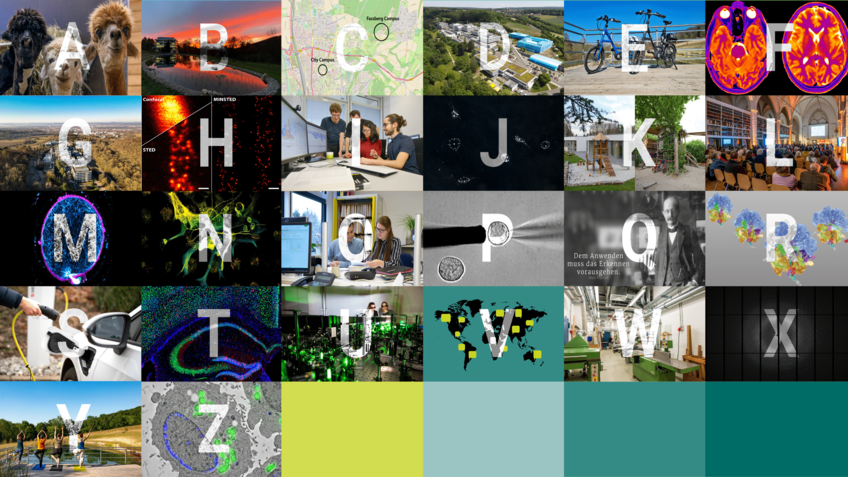
MPI-NAT ABC
A as in Alpaca, N as in Neurobiology, Z as in Zoom – for each letter of the alphabet there is a matching term from our institute. Would you like to learn more about the MPI-NAT? Do not miss our MPI-NAT ABC.
A like Alpaca

Britta, Nora, Xenia, and the rest of our alpaca family enjoy their lives with us on the Fassberg Campus. When they are not busy grazing on their large meadows, they spend their time in their spacious stables.
But why does our institute keep 22 alpacas? The animals provide a scientific service and occasionally donate a small amount of blood to us. Our veterinarian Ulrike Teichmann explains: “The alpacas have a really useful peculiarity: They have special antibodies that can be miniaturized to so-called nanobodies in the lab.” Scientists in the Department of Cellular Logistics, led by Dirk Görlich, work with these nanobodies also because they can be developed into drugs against the coronavirus and other infections. A detailed description of our alpaca antibody research can be found here.
B like BioDiversum

With our biotope project BioDiversum, we want to contribute to biodiversity and help to prevent species extinction. We started in spring 2019 – so far, we enriched our grounds on the Fassberg Campus with:
- Wildflower meadows & flowering shrubs
- Large year-round bird feeder
- Pond
- Nesting boxes for birds and bat boxes
- Meadow orchard
We received the inspiration and motivation to redesign our Fassberg Campus into a biodiverse environment from the well-known ornithologist Peter Berthold. With his vision “A biotope for every community”, the Max Planck emeritus promotes the creation of a dense network of small and large biotopes throughout Germany that are no more than 10 kilometers apart. This way species can spread from one biotope to the next.
At the City Campus, too, the first measures for a small biotope are waiting to be implemented.
Stay informed about all news from the BioDiversum in our blog.
C like Campus

One institute – two locations
If you want to visit us in Göttingen, you should find out in advance whether the City or Fassberg Campus is the right address for you. Why? In 2022, we formed by merging two institutes: The former MPI of Experimental Medicine is now our City Campus opposite the University Medical Center Göttingen, and the previous MPI for Biophysical Chemistry, located on the Fassberg near Nikolausberg, is the Fassberg Campus.
D like Dynamics and Self-Organization
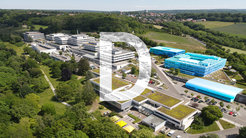
We are not alone on the Fassberg, we actually share one of our locations with the Max Planck Institute for Dynamics and Self-Organization (highlighted in blue).
Our neighbors investigate how interacting parts organize themselves independently into complex systems: For example, how do countless droplets in the atmosphere form a cloud? And how do they influence the Earth’s climate? Or which are the physical principles of self-organization that create living matter? With their research, the scientists thus not only want to gain a better understanding of nature, but also contribute to sustainable life on our planet.
E like E-bikes

You are on the way from the Fassberg Campus to the City Campus or the other way around? Our employees can use the institute e-bikes for that. They are intended to promote exchange between our two locations. With motorized support, the Fassberg will no longer be as big a challenge.
F like Flash

What do you think of when you hear the term FLASH? The superhero? We think of the “Fast Low Angle Shot” technology of Jens Frahm!
Every year, 100 million examinations are performed in the more than 30,000 magnetic resonance imaging (MRI) systems worldwide – and every single scanner uses the technology that Frahm and his team developed. When Paul Lauterbur invented MRI in 1973, a single cross-sectional image took several minutes. This meant that the procedure was too slow and initially failed to gain acceptance in medical diagnostics, until the 1980s. Frahm developed the FLASH technology in 1985, which turned minutes into seconds – a 100-fold acceleration. Since 2010, MRI is even faster. FLASH 2 enables real-time MRI video recordings. For example, beating hearts, breathing thoraxes, speaking or swallowing could suddenly become visible – in real time at up to 100 images per second. This groundbreaking development for medical diagnostics significantly facilitated the detection of various diseases and injuries: ranging from brain abnormalities and internal bleedings to slipped discs or cardiac defects.
Do you want to know what a real-time MRI can look like? Then do not miss the following videos on the YouTube channel of the Max Planck Society:
G like Göttingen

Göttingen – location for science in Southern Lower Saxony
Facts (as of 2019):
- 134,000 inhabitants
- More than 33,000 students
- 1 university and 2 universities of applied sciences (Fachhochschulen)
- More than 15 research institutions
- More than 40 Nobel Prize winners
This is where our institute is at home. With this view of Göttingen, we can only feel good!
H like High, higher, highest resolution
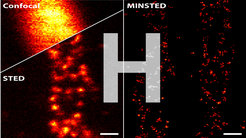
Stefan Hell and his team achieved the highest resolution with the development of the STED microscope. With the 2014 Nobel Prize in Chemistry, he was recognized for founding the research field of fluorescence nanoscopy.
ST – imulated
E – mission
D – epletion
With the STED microscope, Hell succeeded in fundamentally overcoming the previous resolution limit of optical microscopes. In addition, it allows researchers to capture videos of molecular structures in living cells.
Today, STED microscopes are used around the world in many different areas of science. According to Hell, they offer great potential in the study of diseases or helping understand the effects of drugs inside cells.
For a detailed explanation of the trick behind STED, check out a video from the Max Planck Society. It’s worth a watch.
I like IMPRS
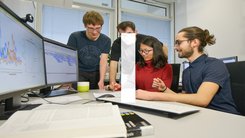
IMPRS stands for International Max Planck Research Schools – a doctoral program of the Max Planck Society (MPS).
In this program, one or more Max Planck Institutes collaborate with universities and other research institutions to provide structured training with excellent research and learning conditions for international PhD candidates. Currently, the MPS maintains 68 IMPRS across Germany with more than 3,000 doctoral students from over 120 nations.
Together with the University of Göttingen and other institutions in Göttingen, our institute manages a total of four Research Schools:
- IMPRS for Genome Science
- IMPRS for Molecular Biology
- IMPRS for Neurosciences
- IMPRS for Physics of Biological and Complex Systems
More about each IMPRS as well as contact information are available here.
J like Jellyfish
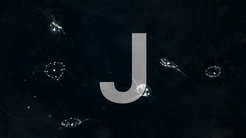
Do you know the smallest animal inhabitants of our institute?
They are transparent, float through the water and are no bigger than 1cm – our jellyfish (Clytia hemisphaerica).
Researchers use them to study oogenesis (egg formation and maturation). Meiosis (maturation division) of oocytes (eggs) is a special form of cell division that results in a fertilizable egg. Peter Lenart and his team from the Cytoskeletal Dynamics in Oocytes research group want to understand how the cell division machinery, in particular the cytoskeleton, has adapted to the process of meiosis.
A well-trained team of experienced animal technicians, veterinarians, and animal welfare officers ensures that our jellyfish are kept in a species-appropriate manner.
K like Kindergarten

Our institute supports the compatibility of family and career with three nurseries, two at the City Campus and one at the Fassberg Campus.
They take care of children from the age of three months to six years old. Two-thirds of the places are reserved for the kids of institute employees, while the remaining spots are available to parents from Göttingen. The kindergartens at the City Campus offer a total of 30 places, the Fassberg Campus 106. Operator is the Kinderhaus Göttingen e.V. association.
L like Literaturherbst

It is hard to imagine the city and region without it – the Göttingen Literaturherbst. Since 1992, the festival celebrates contemporary literature and its authors. For 15 years now, we have been on board with our scientific lecture series, together with the Göttingen Max Planck Institute for Dynamics and Self-Organization, Max Planck Institute for Solar System Research, Max Planck Institute for the Study of Religious and Ethnic Diversity, and the Lower Saxony State and University Library. In our scientific lecture series at the Paulinerkirche, renowned scientists and non-fiction authors present their latest research findings and books and discuss current topics. Since 2014, we also award the Science Communication Medal to a speaker who has shown particular engagement in presenting research results to a broad public in an understandable way.
This fall’s scientific lecture series will once again offer fascinating, spectacular and, of course, literary discoveries.
M like Meiosis

A new life begins when an egg is fertilized by a sperm. In this fusion, the genetic information from each parent is combined. The sperm and egg both contribute a single copy of each of their 23 chromosomes. The newly developing embryo thus inherits a complete set of 46 chromosomes. However, the oocyte – the egg’s precursor cell – contains two copies of every chromosome and must therefore lose half of these before fertilization can take place. This happens in a specialized cell division called meiosis. A complex machinery – the spindle apparatus – ensures that a maturing oocyte retains the correct number of chromosomes. It consists of spindle fibers that attach to the chromosomes during meiosis. The fibers then pull one copy of each chromosome to opposite poles of the spindle, and the oocyte subsequently divides between them. This process is highly error-prone in humans. If too many or too few chromosomes remain in the mature egg, there is a high risk of miscarriage.
Together with her team of the Department of Meiosis, Melina Schuh investigates the mechanisms that control the precise course of meiosis. In doing so, they study how oocytes develop to analyze the causes for chromosome maldistributions in mammalian oocytes.
N like Neurobiology

How is our nervous system structured and how does it work? An emeritus group and two departments at our institute dedicate their research to this central question of neurobiology.
The scientists in the emeritus group Laboratory of Neurobiology led by Reinhard Jahn are working on synaptic vesicles that store chemical messengers through which nerve cells communicate.
Nils Brose and his team investigate how synapses work in the brain and how their malfunction leads to brain diseases in mice. This way, they want to track down causes for human brain diseases, such as autism or schizophrenia.
The scientists led by Klaus-Armin Nave study age-related changes in the nervous system as well as the fundamentals of neurodegenerative diseases. Therefore, they use tools of experimental mouse genetics and cell biology. They put a special focus on the interaction of neurons and their axonal projections with neighboring glial cells.
O like Organization
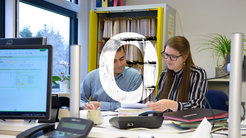
Departments, research groups, emeritus groups, scientific service & facilities – science is, of course, the focus at a research institute. But it takes much more to keep our MPI-NAT running.
The secretaries’ offices and administration support our researchers in all administrative matters. Whether it’s the personnel- or housing administration, the purchasing- or accounting department: They all provide advice and support to the scientists. Sonja Lorenz has much more time for her actual research thanks to this assistance: “The administration at the institute is extremely well organized and takes a lot of bureaucracy off my hands.” Thank you to everyone at our institute who keeps our scientists backs free on the administrative end!
P like Patch Clamp

A method that made it possible to measure the very weak electric current that runs through a single open ion channel in a nerve cell membrane. For this, Erwin Neher and Bert Sakmann received the Nobel Prize for Physiology or Medicine in 1991.
Let us explain: Miniscule ion channels – pore-forming proteins – are embedded within the outer membrane of nearly all cell types. They not only transmit the electrical activity of nerve and muscle cells, but also translate physical and chemical sensory stimuli into neuronal signals. Blood cells, immune cells, and liver cells also use ion channels for communication. These nanomachines in the membrane are therefore not only involved in nerve cell signaling; they also play a crucial role in the messaging systems of organisms.
Q like Quest for understanding

“Insight must precede application.” (Max Planck)
This is the guiding principle of the Max Planck Society and thus of all its institutes that conduct basic research. Even if application is not the focus of research, it often results in pioneering discoveries. At our institute, for example, this was the development of the compound miltefosine, which can combat leishmaniasis (black fever), or the short random repeat technology, which is now used in paternity tests and criminal investigations.
R like Ribosomes
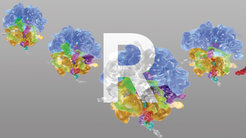
Ribosomes are molecular machines that consist of proteins and RNA. Based on blueprints in our genes, they produce proteins and help them to obtain their correct shape.
Marina Rodnina’s Department of Physical Biochemistry investigates the structure and function of ribosomes. In doing so, the team provides insights into how these molecular machines work, how they ensure that proteins are produced in the right place at the right time, and how quality control occurs.
S like Sustainability

How to integrate sustainability into our institute’s everyday life is the big question for our sustainability initiative. Various measures have already been supported by the initiative:
- Sustainable packaging for shipping research materials
- Recycled printing paper
- Biotope project BioDiversum
- E-bikes and charging stations for EVs
Our colleagues of the initiative have already further projects and ideas in the pipeline. Together for a more sustainable future at the MPI-NAT!
T like Translational Research

In the area of translational research, three teams at our institute are linking basic research with clinically applicable knowledge.
The scientists led by Hannelore Ehrenreich investigate the genetic and environmental underpinnings of neuropsychiatric diseases as well as novel therapeutic strategies to treat them.
Frauke Alves and her team study processes in cancer and lung disease progression by means of high-resolution and non-invasive imaging techniques. Their goal is to develop and evaluate novel diagnostic procedures and therapeutic concepts for clinical use.
Michael Sereda’s group focuses on Charcot-Marie-Tooth disease. The scientists are interested in the molecular mechanisms of the disease and develop novel therapeutic approaches.
U like Ultrafast transmission electron microscope (UTEM)

UTEM stands for Ultrafast Transmission Electron Microscope. It allows for the study of structural, electronic, and magnetic dynamics in solids within millionths of a millimeter and quadrillionths of a second. The Göttingen UTEM is the fastest electron microscope in the world. It was developed by researchers led by Claus Ropers. His department specializes in developing novel experimental tools based on ultrashort, laser-induced electron pulses.
V like Voices

Welcome, willkommen, bienvenido, huān yíng ... If you walk across the Fassberg or City Campus, you hear a lot of different languages. Which one is probably spoken the most there? That’s right: English!
Our employees come from more than 70 different nations and thus combine an enormous linguistic and cultural diversity under one roof. Cultural exchange and intercultural communication greatly enrich our institute, not only in research, but also in our daily interaction.
W like Workshops
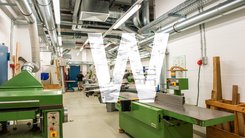
In a scientific institute like the MPI-NAT, the focus usually lies on the researchers and their work. But who supports our scientists when, for example, software problems arise, laboratories are being modified, or the scientific equipment needs to be maintained? In such cases, our technical services and workshops ranging from IT & Electronics Service to Facility Management and Workshop for Precision Mechanics to Carpentry, come to the rescue.
Are you or do you know someone who is interested in a vocational training as an electronics engineer, carpenter, metalworker, IT specialist, or similar? Then take a look at our website (in German).
X like X-ray

X-ray – also known as X-radiation – can be found at our institute in the Facility for Crystallization. This service is part of Patrick Cramer’s Department of Molecular Biology. But what do our researchers actually use X-rays for?
The answer: for a process called ‘X-ray crystallography’. It is a method to perform structural analyses of large molecules such as proteins or nucleic acids. The goal is to understand what these molecules look like in detail – at an atomic scale. The structure of a protein, for example, provides information about its function in our cells. Because the molecules are so incredibly small, for a long time their atomic structures could not be resolved with microscopes. With the help of X-ray crystallography, however, this is possible – provided that identical protein (building blocks) can each be arranged into a three-dimensional crystal lattice. Such a crystal lattice generates diffraction patterns (see figure X) when scientists expose it to X-rays.
Y like Yoga

Dog, cat and the like – here we do not mean animals, but yoga postures, that employees at our institute use to keep fit. In addition, our Corporate Health Management (Betriebliches Gesundheitsmanagement, BGM) offers a diverse program rangings from fitness courses to city cycling and outdoor training devices to diagnostic massages. With BGM, the institute wants to achieve an improvement in health, motivation, and satisfaction at the workplace. So let’s get on the mats!
You can read more in the article about the BGM in the latest issue of our institute magazine INSIDE NAT.
Z like Zoom

We are not talking about the well-known video conferencing tool that has been with us for over two years now. Here we refer to the zoom in microscopes.
At our institute, we use a wide range of state-of-the-art methods. From (cryo) electron microscopy and (fluorescence) light microscopy to live cell microscopy. With these technologies, our scientific facilities actively support the departments and groups in their research.
The full range of scientific services and facilities at the MPI-NAT can be found here.

























